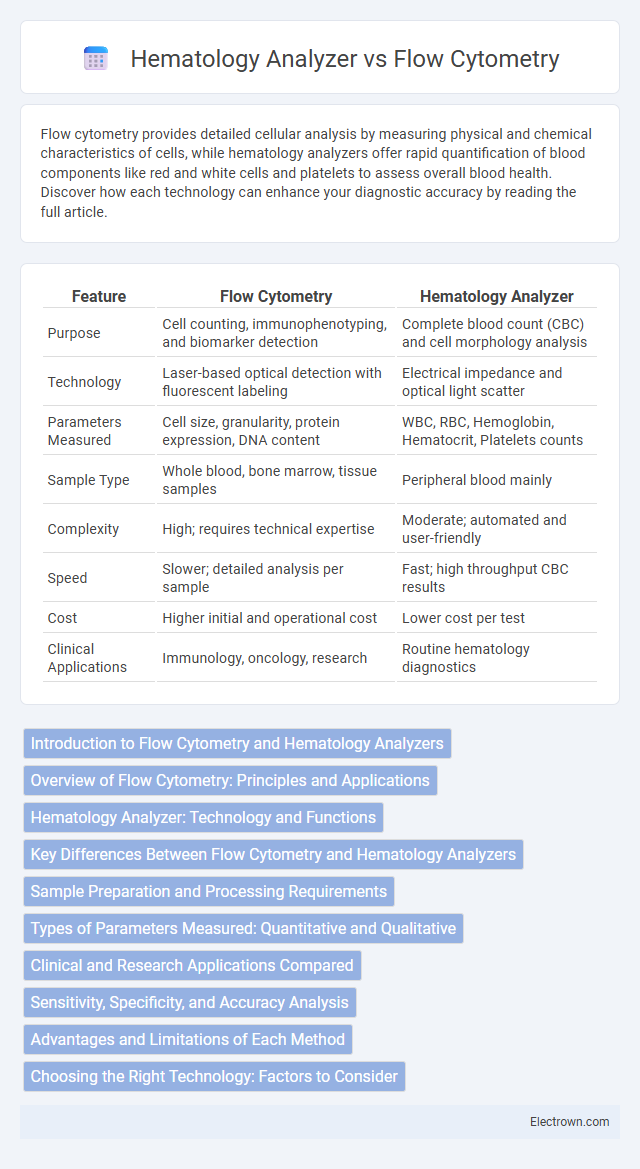Flow cytometry provides detailed cellular analysis by measuring physical and chemical characteristics of cells, while hematology analyzers offer rapid quantification of blood components like red and white cells and platelets to assess overall blood health. Discover how each technology can enhance your diagnostic accuracy by reading the full article.
Table of Comparison
| Feature | Flow Cytometry | Hematology Analyzer |
|---|---|---|
| Purpose | Cell counting, immunophenotyping, and biomarker detection | Complete blood count (CBC) and cell morphology analysis |
| Technology | Laser-based optical detection with fluorescent labeling | Electrical impedance and optical light scatter |
| Parameters Measured | Cell size, granularity, protein expression, DNA content | WBC, RBC, Hemoglobin, Hematocrit, Platelets counts |
| Sample Type | Whole blood, bone marrow, tissue samples | Peripheral blood mainly |
| Complexity | High; requires technical expertise | Moderate; automated and user-friendly |
| Speed | Slower; detailed analysis per sample | Fast; high throughput CBC results |
| Cost | Higher initial and operational cost | Lower cost per test |
| Clinical Applications | Immunology, oncology, research | Routine hematology diagnostics |
Introduction to Flow Cytometry and Hematology Analyzers
Flow cytometry utilizes laser technology to analyze the physical and chemical characteristics of cells or particles in a fluid as they pass through a detection apparatus, offering detailed multiparametric data on size, granularity, and protein expression. Hematology analyzers automate the complete blood count (CBC) by measuring various blood components like red and white blood cells, platelets, and hemoglobin concentration, primarily using impedance or optical methods. Both tools are essential in clinical diagnostics, with flow cytometry providing more specific cellular information and hematology analyzers delivering rapid, routine blood parameter results.
Overview of Flow Cytometry: Principles and Applications
Flow cytometry utilizes laser-based technology to analyze physical and chemical characteristics of cells or particles suspended in fluid, enabling multiparametric data collection in real time. This technique assesses cell size, granularity, and protein expression through fluorescently labeled antibodies, making it essential for immunophenotyping, cell sorting, and diagnosis of hematologic malignancies. In contrast to hematology analyzers that primarily provide automated cell counts and basic differentiation, flow cytometry offers detailed insights into cellular functions and biomarker profiling crucial for advanced clinical and research applications.
Hematology Analyzer: Technology and Functions
Hematology analyzers employ advanced optical and impedance technologies to rapidly measure and count blood cells, including red blood cells, white blood cells, and platelets. These devices provide detailed cell indices such as mean corpuscular volume (MCV), hemoglobin concentration, and platelet distribution width, essential for diagnosing anemia, infections, and clotting disorders. Your laboratory benefits from automation, high throughput, and standardized results, enabling accurate hematological assessments with minimal manual intervention.
Key Differences Between Flow Cytometry and Hematology Analyzers
Flow cytometry provides detailed cellular analysis by measuring physical and chemical characteristics of cells using laser-based technology, while hematology analyzers perform automated counting and classification of blood cells primarily through electrical impedance or optical methods. You will find flow cytometry excels in identifying specific cell populations and immunophenotyping, essential for diagnosing complex diseases, whereas hematology analyzers offer rapid complete blood counts for routine screening. The key difference lies in flow cytometry's multidimensional data output versus the hematology analyzer's focus on cell counts and general morphology.
Sample Preparation and Processing Requirements
Flow cytometry requires complex sample preparation involving cell staining with fluorescent antibodies and requires skilled technicians to ensure accurate gating and analysis. Hematology analyzers utilize simpler processing, often requiring whole blood samples with minimal preparation for rapid cell counting and differentiation. The extensive preparation in flow cytometry allows for detailed immunophenotyping, whereas hematology analyzers prioritize speed and routine blood parameter quantification.
Types of Parameters Measured: Quantitative and Qualitative
Flow cytometry measures both quantitative and qualitative parameters by analyzing physical and chemical characteristics of cells, such as size, granularity, surface markers, and fluorescence intensity, providing detailed identification of cell populations. Hematology analyzers primarily provide quantitative data on blood components, including red and white blood cell counts, hemoglobin concentration, and platelet numbers, with some models offering limited qualitative assessments like cell size distribution. Your choice depends on whether detailed cellular characterization (flow cytometry) or rapid, broad-spectrum blood analysis (hematology analyzer) best suits your diagnostic needs.
Clinical and Research Applications Compared
Flow cytometry offers detailed analysis of cell populations, enabling precise immunophenotyping and biomarker detection, crucial for advanced clinical diagnostics and cutting-edge research. Hematology analyzers provide rapid, automated quantification of blood cell counts, essential for routine clinical hematology and large-scale population screening. Your choice depends on the requirement for detailed cellular characterization in research or rapid, broad blood analysis in clinical practice.
Sensitivity, Specificity, and Accuracy Analysis
Flow cytometry offers higher sensitivity and specificity compared to hematology analyzers by precisely analyzing individual cell characteristics using fluorescent markers, enabling detailed immunophenotyping. Hematology analyzers provide rapid, automated quantification of blood components with good accuracy but are limited in distinguishing complex cell populations or detecting rare cell types. Your choice between these technologies depends on the clinical need for detailed cellular analysis versus routine blood count accuracy and throughput.
Advantages and Limitations of Each Method
Flow Cytometry offers high precision in identifying and quantifying multiple cell populations simultaneously, making it ideal for detailed immunophenotyping and complex cellular analysis. Hematology Analyzers provide rapid, automated blood cell counts with ease of use and cost-effectiveness, suitable for routine clinical diagnostics but limited in detailed cell characterization. Understanding your diagnostic needs helps determine whether the depth of Flow Cytometry or the efficiency of Hematology Analyzers best supports your laboratory workflow.
Choosing the Right Technology: Factors to Consider
Selecting between Flow Cytometry and Hematology Analyzer depends on clinical requirements such as the need for detailed cellular analysis versus routine blood counts. Flow Cytometry offers precise immunophenotyping and identification of rare cell populations, ideal for complex diagnostics and research settings. Hematology Analyzers provide rapid, automated complete blood count (CBC) with differential, making them suitable for high-throughput clinical laboratories focused on general hematologic screening.
Flow Cytometry vs Hematology Analyzer Infographic

 electrown.com
electrown.com